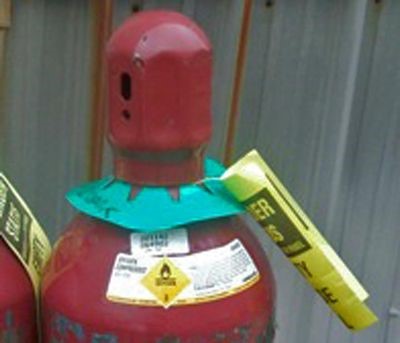Miscellaneous Best Practices
Compressed Gas Cylinders
When working with compressed gas cylinders, follow these best practices:
- Return them promptly to a suitable storage area after use.
- Locate storage areas away from general and emergency escape traffic paths.

Tagged compressed gas cylinder
- Divide cylinder storage areas in to areas marked as 'full' and 'empty' by tagging the cylinders.
- Oxygen cylinders should be stored at least 20 feet away from fuel-gas cylinders or combustible materials (especially oil or grease). As an alternative, a non-combustible barrier, at least five feet high, can be used with a fire-resistance rating of at least one-half hour.
- Separate cylinders containing substances that, if mixed, could produce an explosive or fire hazard. For example, do not store acetylene and oxygen cylinders together unless they are stored in an approved bottle-rack carrier, per NFPA Standard 55.
- When not in use, close cylinder valves and depressurize connecting hoses.
- Be sure that valve protection caps are in place on cylinders whenever they are not connected for use or while they are being transported.
- Store, transport, and use compressed gas cylinders in accordance with manufacturer's specifications and NFPA codes
- Secure cylinders to substantial stationary objects or structures by a chain or other suitable means capable of supporting the weight of the cylinder.
Knowledge Check Choose the best answer for the question.
7-1. Oxygen cylinders should be stored _____ fuel-gas cylinders or combustible materials.
You forgot to answer the question!
